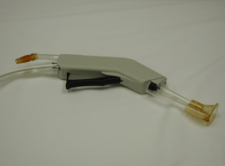Modalities Utilized in Wound Healing: Pulsed Lavage
In the last segment, we discussed whirlpool treatments; however, in some cases whirlpool is not convenient or available. When whirlpool is not an option, pulsed lavage with or without suction may be used.
Functions
Pulsed lavage uses a wound irrigant under pressure, which is powered by an electronic device, to irrigate and cleanse the wound. Saline or tap water is typically used as the irrigant. Using a handheld device, fluid flow pressure is controlled with automatic interruption of the flow. When suction is used along with pulsed lavage, negative pressure is applied to the wound bed, which allows for removal of the irrigant. Negative pressure is applied to remove pathogens and to promote epithelialization, removal of pathogens, formation of granulation tissue and perfusion of local tissue. Pulsed lavage with suction is considered to be the standard of care for irrigation of wounds.
Indications\Precautions
Pulsed lavage can be used to cleanse or debride wounds caused by venous insufficiency, surgery, trauma, arterial insufficiency, diabetes, burns and/or pressure. Pulsed lavage is also safe for use on wounds with tunneling or undermining due to the fact that special tips are available to facilitate irrigation of these areas. It is particularly useful during the inflammatory phase of wound healing because it helps to soften and remove dead tissue and exudate. Pulsed lavage along with suction can be helpful during the proliferative phase of wound healing to promote epithelialization and granular tissue formation.
Contraindications\Precautions
When there are exposed nerves, tendons, arteries or bones, pulsed lavage with suction should not be used. It should also be avoided in facial wounds, wounds that are actively bleeding, body cavities and on recent grafts. Use pulsed lavage cautiously on patients taking anticoagulants due to the risk of bleeding. Patients with decreased sensation may be unable to perceive trauma, and patients whose wounds have deep tunnels may experience trauma from the probing tip. Irrigation pressure should be maintained at 15 psi or less to avoid bacterial penetration into wound tissues. Tubing and tips of some older pulsed lavage units may contain latex, and therefore cannot be used on patients who have an allergy or sensitivity to latex.
How to Perform
Prior to performing the procedure, you should explain the procedure to the patient to ensure full understanding and compliance. Position the patient comfortably to allow access to the wound. Remove all dressings and drape the patient for modesty. Remember to pad the area with towels or other absorbent material to avoid soaking patient’s clothing. Provide the patient with a mask to wear during treatment to prevent aerosolization of pathogens. You should also wear appropriate barrier devices, including a mask, gown and gloves. If possible, the irrigant reservoir, which usually holds one or more bags of normal saline, should be warmed to between 102 and 106°F to prevent hypothermia. Following, the irrigant may be hung from an intravenous pole within reach of the patient’s wound. The tubing is then attached to the irrigant reservoir and suction device (if one is used). Somewhere between 1000 and 3000 mls of irrigant is needed for thorough wound irrigation. Turn the pump on and adjust the pressure to between 4 and 15 psi. Use lower pressures when tunneling or undermining is present. Treatments require 15 to 30 minutes. Following treatment, dry intact skin with a towel. Open areas may be patted gently with sterile gauze to absorb the irrigant. Next, perform any debriding or measurements, and then bandage the wound and dispose of equipment according to policy. Lastly, you should wipe down any surfaces in the room to prevent cross- contamination. Pulsed lavage may be performed anywhere from twice daily to two or three times per week.
Patient Considerations
Using irrigant that has not been warmed may increase patient discomfort. Pulsed lavage is often less painful than whirlpool. It is important to assess patient comfort throughout the procedure. Decrease pressure if the patient complains of pain.
Advantages/Disadvantages
Pulsed lavage with suction has many advantages over whirlpool treatments, including:
- greater portability
- shorter treatment times
- less risk of cross-contamination
- less stress to the patient
- increased cost savings
- ability to use when whirlpool is unavailable or contraindicated
- can be used to treat small areas
Disadvantages include significant waste because the tubing and wound tips for pulsed lavage must be discarded after use, which can also increase treatment cost. Another disadvantage is that pulsed lavage is inappropriate for large and extensive wounds, such as burns affecting large surface areas.
In the next section, we will discuss the use of electrical stimulation in wound healing. If you enjoy learning about wound care, consider becoming certified in wound management. Wound Educators is the foremost online wound education forum, offering wound certification courses for healthcare professionals.
Sources
Gabriel, A. (2013). Wound irrigation. Medscape. http://emedicine.medscape.com/article/1895071-overview
Perry, A., Potter, P. & Ostendorf, W. (2013). Clinical Nursing Skills and Techniques. 8th edition. Elsevier Health Sciences.


I got from my country a MD degree(Mexico),wonder, what requirements are necessary to get a certification
For detailed information visit our wound care certification courses page, or contact us directly.
This article is nice and very informative for the applications of pulse lavage in wound care. I am doing a market assessment of Pulse Lavage Systems and have segmented the market in different ways. Could you please provide me your feedback on following segmentation? Let me know if any fine-tuning is needed.
Pulse Lavage Systems Market, by Product
Disposable Pulse lavage systems
Reusable Pulse lavage systems
Semi-disposable Pulse lavage systems
Pulse Lavage Systems Market, by Product
Pulse Lavage Devices
Components and Accessories
• Batteries
• Irrigation Tips
• Irrigation Tubings
• Other (Waste pipe, Irrigation Bag, Adaptors, splash shields, nozzles, Power wire, clamps)
Pulse Lavage Systems Market, by Application
Orthopedics
• Joint Reconstruction
Knee Joints
Hip Joints
Others
• Spinal Implants
• Others
Wound Care
• Chronic Wounds
• Acute Wounds
Trauma
Thank you!
Kalpesh Jain (Sr. Analyst @ Meticulous research, India)